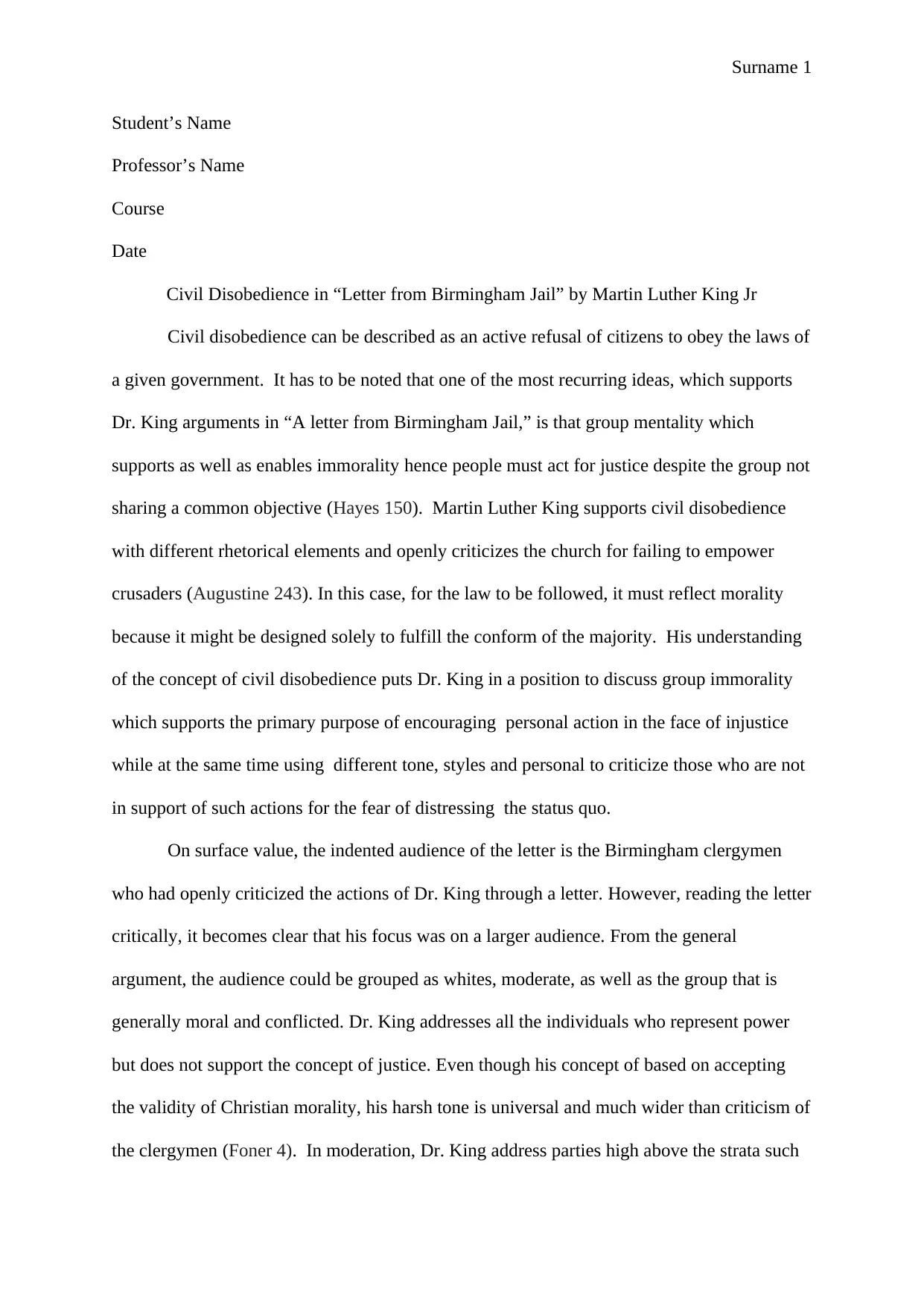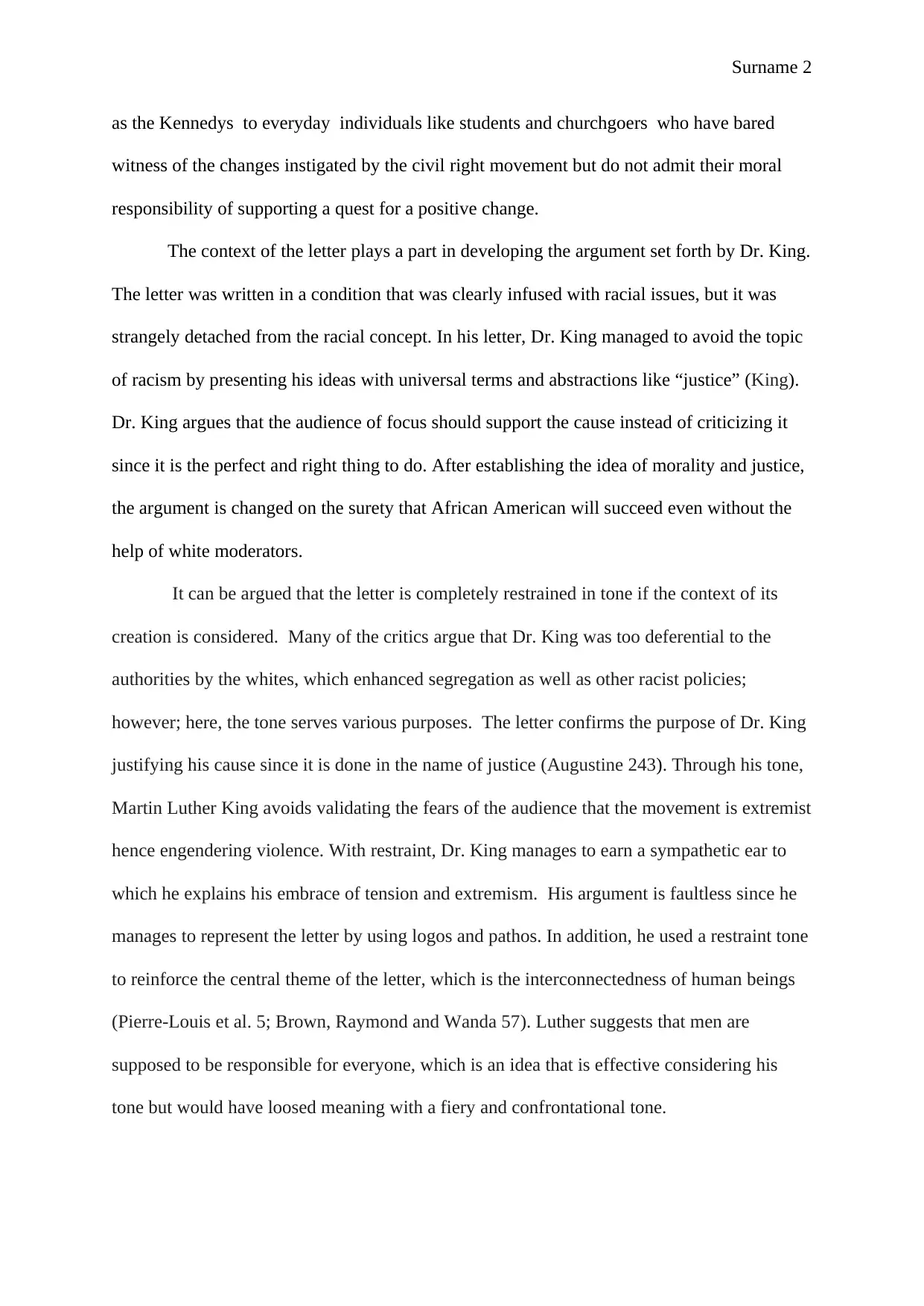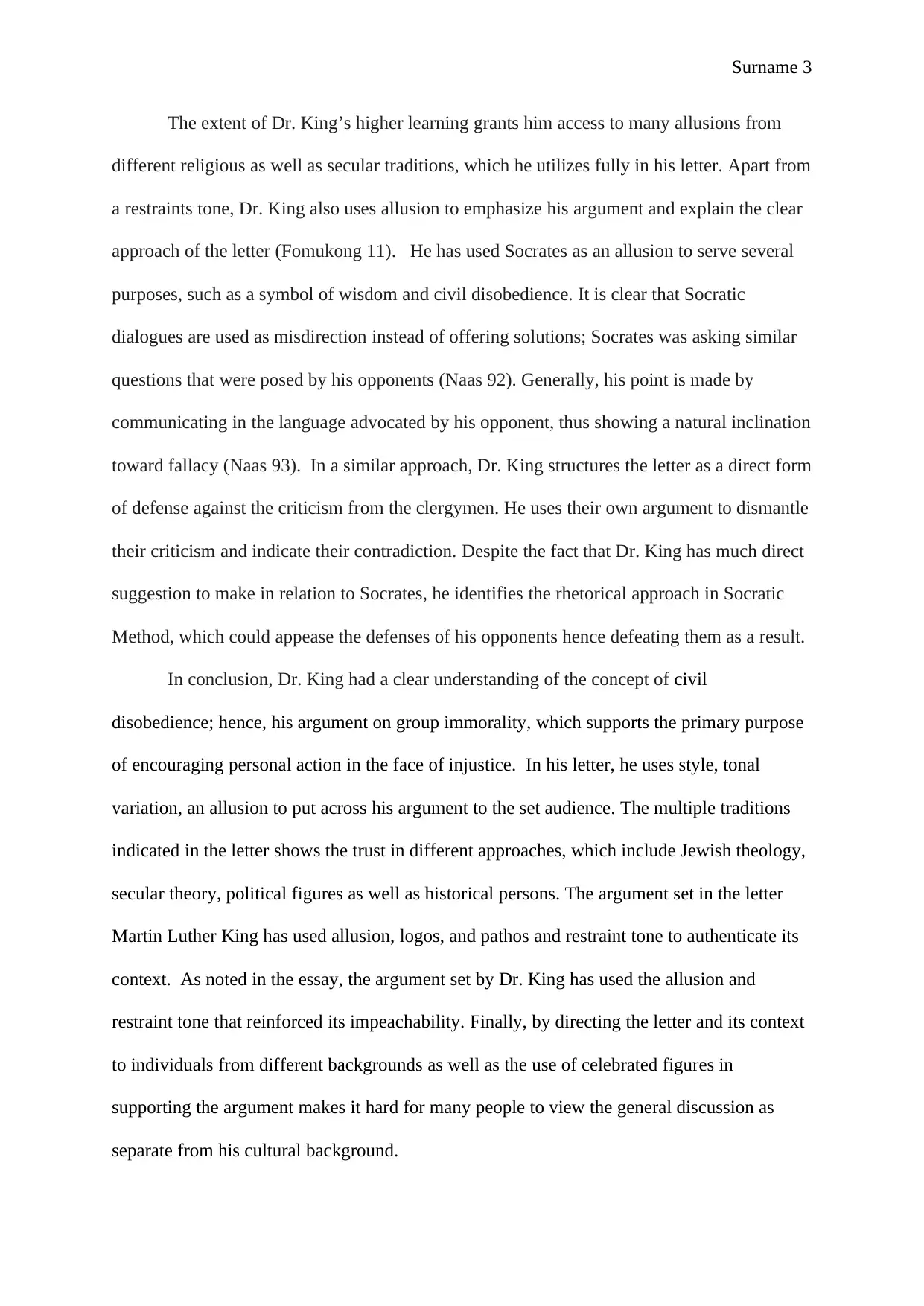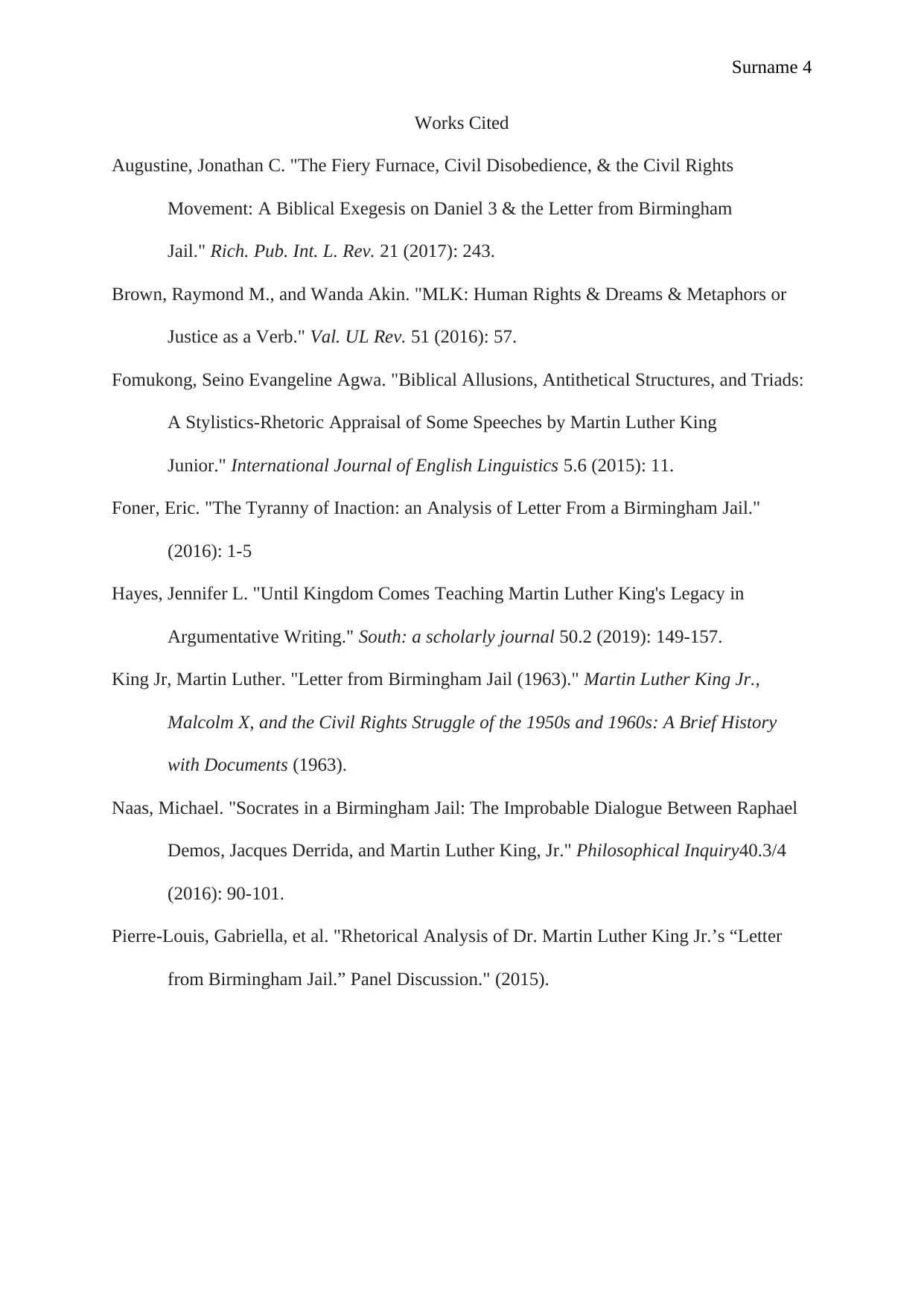Martin Luther King Jr.'s Letter: Civil Disobedience Analysis
VerifiedAdded on 2022/11/25
|4
|1443
|252
Essay
AI Summary
This essay provides an analysis of Martin Luther King Jr.'s "Letter from Birmingham Jail," focusing on his arguments for civil disobedience and the rhetorical strategies he employed. The essay examines King's definition of civil disobedience, his critique of the church, and his appeals to a diverse audience, including whites, moderates, and the morally conflicted. It explores the context of the letter, emphasizing how King avoided the topic of racism by using universal terms like "justice." The essay also discusses King's restrained tone, his use of allusions, and his application of logos and pathos to support his central theme of the interconnectedness of human beings. Furthermore, it highlights King's use of Socratic methods and allusions to reinforce his argument and dismantle the criticisms from the clergymen. The conclusion summarizes King's understanding of civil disobedience and his effective use of style, tone, and allusion to convey his message.

Surname 1
Student’s Name
Professor’s Name
Course
Date
Civil Disobedience in “Letter from Birmingham Jail” by Martin Luther King Jr
Civil disobedience can be described as an active refusal of citizens to obey the laws of
a given government. It has to be noted that one of the most recurring ideas, which supports
Dr. King arguments in “A letter from Birmingham Jail,” is that group mentality which
supports as well as enables immorality hence people must act for justice despite the group not
sharing a common objective (Hayes 150). Martin Luther King supports civil disobedience
with different rhetorical elements and openly criticizes the church for failing to empower
crusaders (Augustine 243). In this case, for the law to be followed, it must reflect morality
because it might be designed solely to fulfill the conform of the majority. His understanding
of the concept of civil disobedience puts Dr. King in a position to discuss group immorality
which supports the primary purpose of encouraging personal action in the face of injustice
while at the same time using different tone, styles and personal to criticize those who are not
in support of such actions for the fear of distressing the status quo.
On surface value, the indented audience of the letter is the Birmingham clergymen
who had openly criticized the actions of Dr. King through a letter. However, reading the letter
critically, it becomes clear that his focus was on a larger audience. From the general
argument, the audience could be grouped as whites, moderate, as well as the group that is
generally moral and conflicted. Dr. King addresses all the individuals who represent power
but does not support the concept of justice. Even though his concept of based on accepting
the validity of Christian morality, his harsh tone is universal and much wider than criticism of
the clergymen (Foner 4). In moderation, Dr. King address parties high above the strata such
Student’s Name
Professor’s Name
Course
Date
Civil Disobedience in “Letter from Birmingham Jail” by Martin Luther King Jr
Civil disobedience can be described as an active refusal of citizens to obey the laws of
a given government. It has to be noted that one of the most recurring ideas, which supports
Dr. King arguments in “A letter from Birmingham Jail,” is that group mentality which
supports as well as enables immorality hence people must act for justice despite the group not
sharing a common objective (Hayes 150). Martin Luther King supports civil disobedience
with different rhetorical elements and openly criticizes the church for failing to empower
crusaders (Augustine 243). In this case, for the law to be followed, it must reflect morality
because it might be designed solely to fulfill the conform of the majority. His understanding
of the concept of civil disobedience puts Dr. King in a position to discuss group immorality
which supports the primary purpose of encouraging personal action in the face of injustice
while at the same time using different tone, styles and personal to criticize those who are not
in support of such actions for the fear of distressing the status quo.
On surface value, the indented audience of the letter is the Birmingham clergymen
who had openly criticized the actions of Dr. King through a letter. However, reading the letter
critically, it becomes clear that his focus was on a larger audience. From the general
argument, the audience could be grouped as whites, moderate, as well as the group that is
generally moral and conflicted. Dr. King addresses all the individuals who represent power
but does not support the concept of justice. Even though his concept of based on accepting
the validity of Christian morality, his harsh tone is universal and much wider than criticism of
the clergymen (Foner 4). In moderation, Dr. King address parties high above the strata such
Paraphrase This Document
Need a fresh take? Get an instant paraphrase of this document with our AI Paraphraser

Surname 2
as the Kennedys to everyday individuals like students and churchgoers who have bared
witness of the changes instigated by the civil right movement but do not admit their moral
responsibility of supporting a quest for a positive change.
The context of the letter plays a part in developing the argument set forth by Dr. King.
The letter was written in a condition that was clearly infused with racial issues, but it was
strangely detached from the racial concept. In his letter, Dr. King managed to avoid the topic
of racism by presenting his ideas with universal terms and abstractions like “justice” (King).
Dr. King argues that the audience of focus should support the cause instead of criticizing it
since it is the perfect and right thing to do. After establishing the idea of morality and justice,
the argument is changed on the surety that African American will succeed even without the
help of white moderators.
It can be argued that the letter is completely restrained in tone if the context of its
creation is considered. Many of the critics argue that Dr. King was too deferential to the
authorities by the whites, which enhanced segregation as well as other racist policies;
however; here, the tone serves various purposes. The letter confirms the purpose of Dr. King
justifying his cause since it is done in the name of justice (Augustine 243). Through his tone,
Martin Luther King avoids validating the fears of the audience that the movement is extremist
hence engendering violence. With restraint, Dr. King manages to earn a sympathetic ear to
which he explains his embrace of tension and extremism. His argument is faultless since he
manages to represent the letter by using logos and pathos. In addition, he used a restraint tone
to reinforce the central theme of the letter, which is the interconnectedness of human beings
(Pierre-Louis et al. 5; Brown, Raymond and Wanda 57). Luther suggests that men are
supposed to be responsible for everyone, which is an idea that is effective considering his
tone but would have loosed meaning with a fiery and confrontational tone.
as the Kennedys to everyday individuals like students and churchgoers who have bared
witness of the changes instigated by the civil right movement but do not admit their moral
responsibility of supporting a quest for a positive change.
The context of the letter plays a part in developing the argument set forth by Dr. King.
The letter was written in a condition that was clearly infused with racial issues, but it was
strangely detached from the racial concept. In his letter, Dr. King managed to avoid the topic
of racism by presenting his ideas with universal terms and abstractions like “justice” (King).
Dr. King argues that the audience of focus should support the cause instead of criticizing it
since it is the perfect and right thing to do. After establishing the idea of morality and justice,
the argument is changed on the surety that African American will succeed even without the
help of white moderators.
It can be argued that the letter is completely restrained in tone if the context of its
creation is considered. Many of the critics argue that Dr. King was too deferential to the
authorities by the whites, which enhanced segregation as well as other racist policies;
however; here, the tone serves various purposes. The letter confirms the purpose of Dr. King
justifying his cause since it is done in the name of justice (Augustine 243). Through his tone,
Martin Luther King avoids validating the fears of the audience that the movement is extremist
hence engendering violence. With restraint, Dr. King manages to earn a sympathetic ear to
which he explains his embrace of tension and extremism. His argument is faultless since he
manages to represent the letter by using logos and pathos. In addition, he used a restraint tone
to reinforce the central theme of the letter, which is the interconnectedness of human beings
(Pierre-Louis et al. 5; Brown, Raymond and Wanda 57). Luther suggests that men are
supposed to be responsible for everyone, which is an idea that is effective considering his
tone but would have loosed meaning with a fiery and confrontational tone.

Surname 3
The extent of Dr. King’s higher learning grants him access to many allusions from
different religious as well as secular traditions, which he utilizes fully in his letter. Apart from
a restraints tone, Dr. King also uses allusion to emphasize his argument and explain the clear
approach of the letter (Fomukong 11). He has used Socrates as an allusion to serve several
purposes, such as a symbol of wisdom and civil disobedience. It is clear that Socratic
dialogues are used as misdirection instead of offering solutions; Socrates was asking similar
questions that were posed by his opponents (Naas 92). Generally, his point is made by
communicating in the language advocated by his opponent, thus showing a natural inclination
toward fallacy (Naas 93). In a similar approach, Dr. King structures the letter as a direct form
of defense against the criticism from the clergymen. He uses their own argument to dismantle
their criticism and indicate their contradiction. Despite the fact that Dr. King has much direct
suggestion to make in relation to Socrates, he identifies the rhetorical approach in Socratic
Method, which could appease the defenses of his opponents hence defeating them as a result.
In conclusion, Dr. King had a clear understanding of the concept of civil
disobedience; hence, his argument on group immorality, which supports the primary purpose
of encouraging personal action in the face of injustice. In his letter, he uses style, tonal
variation, an allusion to put across his argument to the set audience. The multiple traditions
indicated in the letter shows the trust in different approaches, which include Jewish theology,
secular theory, political figures as well as historical persons. The argument set in the letter
Martin Luther King has used allusion, logos, and pathos and restraint tone to authenticate its
context. As noted in the essay, the argument set by Dr. King has used the allusion and
restraint tone that reinforced its impeachability. Finally, by directing the letter and its context
to individuals from different backgrounds as well as the use of celebrated figures in
supporting the argument makes it hard for many people to view the general discussion as
separate from his cultural background.
The extent of Dr. King’s higher learning grants him access to many allusions from
different religious as well as secular traditions, which he utilizes fully in his letter. Apart from
a restraints tone, Dr. King also uses allusion to emphasize his argument and explain the clear
approach of the letter (Fomukong 11). He has used Socrates as an allusion to serve several
purposes, such as a symbol of wisdom and civil disobedience. It is clear that Socratic
dialogues are used as misdirection instead of offering solutions; Socrates was asking similar
questions that were posed by his opponents (Naas 92). Generally, his point is made by
communicating in the language advocated by his opponent, thus showing a natural inclination
toward fallacy (Naas 93). In a similar approach, Dr. King structures the letter as a direct form
of defense against the criticism from the clergymen. He uses their own argument to dismantle
their criticism and indicate their contradiction. Despite the fact that Dr. King has much direct
suggestion to make in relation to Socrates, he identifies the rhetorical approach in Socratic
Method, which could appease the defenses of his opponents hence defeating them as a result.
In conclusion, Dr. King had a clear understanding of the concept of civil
disobedience; hence, his argument on group immorality, which supports the primary purpose
of encouraging personal action in the face of injustice. In his letter, he uses style, tonal
variation, an allusion to put across his argument to the set audience. The multiple traditions
indicated in the letter shows the trust in different approaches, which include Jewish theology,
secular theory, political figures as well as historical persons. The argument set in the letter
Martin Luther King has used allusion, logos, and pathos and restraint tone to authenticate its
context. As noted in the essay, the argument set by Dr. King has used the allusion and
restraint tone that reinforced its impeachability. Finally, by directing the letter and its context
to individuals from different backgrounds as well as the use of celebrated figures in
supporting the argument makes it hard for many people to view the general discussion as
separate from his cultural background.
⊘ This is a preview!⊘
Do you want full access?
Subscribe today to unlock all pages.

Trusted by 1+ million students worldwide

Surname 4
Works Cited
Augustine, Jonathan C. "The Fiery Furnace, Civil Disobedience, & the Civil Rights
Movement: A Biblical Exegesis on Daniel 3 & the Letter from Birmingham
Jail." Rich. Pub. Int. L. Rev. 21 (2017): 243.
Brown, Raymond M., and Wanda Akin. "MLK: Human Rights & Dreams & Metaphors or
Justice as a Verb." Val. UL Rev. 51 (2016): 57.
Fomukong, Seino Evangeline Agwa. "Biblical Allusions, Antithetical Structures, and Triads:
A Stylistics-Rhetoric Appraisal of Some Speeches by Martin Luther King
Junior." International Journal of English Linguistics 5.6 (2015): 11.
Foner, Eric. "The Tyranny of Inaction: an Analysis of Letter From a Birmingham Jail."
(2016): 1-5
Hayes, Jennifer L. "Until Kingdom Comes Teaching Martin Luther King's Legacy in
Argumentative Writing." South: a scholarly journal 50.2 (2019): 149-157.
King Jr, Martin Luther. "Letter from Birmingham Jail (1963)." Martin Luther King Jr.,
Malcolm X, and the Civil Rights Struggle of the 1950s and 1960s: A Brief History
with Documents (1963).
Naas, Michael. "Socrates in a Birmingham Jail: The Improbable Dialogue Between Raphael
Demos, Jacques Derrida, and Martin Luther King, Jr." Philosophical Inquiry40.3/4
(2016): 90-101.
Pierre-Louis, Gabriella, et al. "Rhetorical Analysis of Dr. Martin Luther King Jr.’s “Letter
from Birmingham Jail.” Panel Discussion." (2015).
Works Cited
Augustine, Jonathan C. "The Fiery Furnace, Civil Disobedience, & the Civil Rights
Movement: A Biblical Exegesis on Daniel 3 & the Letter from Birmingham
Jail." Rich. Pub. Int. L. Rev. 21 (2017): 243.
Brown, Raymond M., and Wanda Akin. "MLK: Human Rights & Dreams & Metaphors or
Justice as a Verb." Val. UL Rev. 51 (2016): 57.
Fomukong, Seino Evangeline Agwa. "Biblical Allusions, Antithetical Structures, and Triads:
A Stylistics-Rhetoric Appraisal of Some Speeches by Martin Luther King
Junior." International Journal of English Linguistics 5.6 (2015): 11.
Foner, Eric. "The Tyranny of Inaction: an Analysis of Letter From a Birmingham Jail."
(2016): 1-5
Hayes, Jennifer L. "Until Kingdom Comes Teaching Martin Luther King's Legacy in
Argumentative Writing." South: a scholarly journal 50.2 (2019): 149-157.
King Jr, Martin Luther. "Letter from Birmingham Jail (1963)." Martin Luther King Jr.,
Malcolm X, and the Civil Rights Struggle of the 1950s and 1960s: A Brief History
with Documents (1963).
Naas, Michael. "Socrates in a Birmingham Jail: The Improbable Dialogue Between Raphael
Demos, Jacques Derrida, and Martin Luther King, Jr." Philosophical Inquiry40.3/4
(2016): 90-101.
Pierre-Louis, Gabriella, et al. "Rhetorical Analysis of Dr. Martin Luther King Jr.’s “Letter
from Birmingham Jail.” Panel Discussion." (2015).
1 out of 4
Related Documents
Your All-in-One AI-Powered Toolkit for Academic Success.
+13062052269
info@desklib.com
Available 24*7 on WhatsApp / Email
![[object Object]](/_next/static/media/star-bottom.7253800d.svg)
Unlock your academic potential
Copyright © 2020–2025 A2Z Services. All Rights Reserved. Developed and managed by ZUCOL.





